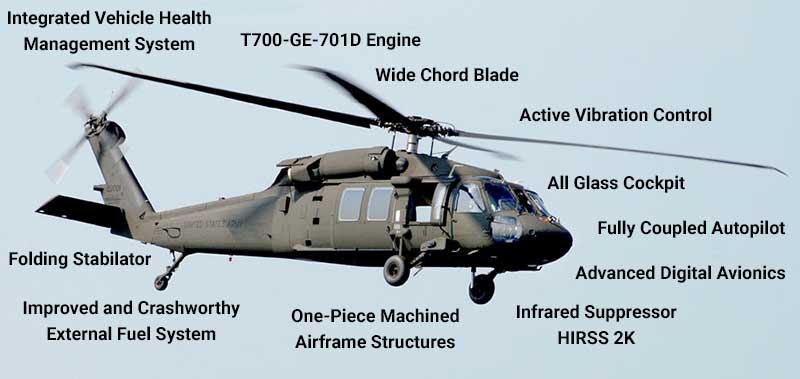Achieving Quality: Key Approaches for UH 60 Helicopter Maintenance
Wiki Article
Comprehending the Mechanics and Design Behind Uh 60 Helicopters
The UH-60 helicopter, frequently understood as the Black Hawk, stands as a pinnacle of modern rotorcraft innovation, symbolizing a mix of robust engineering and complex auto mechanics. As we peel back the layers of the UH-60's design, a globe of complex systems and precise design comes to light.History of UH-60 Helicopters
The background of UH-60 helicopters traces back to the late 1970s when the USA Army looked for a versatile and sophisticated energy helicopter to replace its aging fleet. In action to this need, the Sikorsky Airplane Corporation created the UH-60 Black Hawk helicopter. Introduced in 1979, the UH-60 quickly became a staple in military operations because of its impressive capacities.
The UH-60 was created to excel in a selection of goals, including army transportation, clinical emptying, electronic war, and special procedures. Its capability to adjust to various duties made it a useful property to the united state Military and various other military pressures around the globe
For many years, the UH-60 system has undergone a number of upgrades and variations to boost its performance and equal evolving goal demands. These helicopters have actually seen extensive solution in problems such as the Gulf Battle, Afghanistan, and Iraq, showcasing their dependability and adaptability in diverse operational settings. The UH-60's rich background is a testament to its enduring legacy as a top energy helicopter.

Engine and Power Solutions
Utilizing sophisticated propulsion innovation, UH-60 helicopters are outfitted with sophisticated engine and power systems to ensure ideal performance and dependability in a range of functional situations. The UH-60, typically recognized as the Black Hawk, is powered by two General Electric T700-GE-701D engines, each qualified of supplying up to 1,940 shaft horsepower. These turboshaft engines offer the required thrust for the helicopter to lug out its missions properly, including army transportation, medical emptying, and battle assistance.
Blades System and Aerodynamics
Just how do the rotor system and aerodynamics of UH-60 helicopters contribute to their functional performance and flight abilities? The blades system look at here of the UH-60 helicopter plays a critical duty in providing lift and propulsion. The UH-60 includes a four-bladed, totally expressed blades system that permits high ability to move and stability during flight. This style makes it possible for the helicopter to perform a vast array of goals, from transport and clinical emptying to combat procedures.Aerodynamics likewise play an essential duty in the performance of UH-60 helicopters. The structured fuselage and rotor blade style reduce drag, permitting the helicopter to attain greater speeds and much better gas effectiveness. The wind resistant layout of the UH-60 also adds to its capacity to operate in diverse environmental conditions, including warm temperature levels and high altitudes.
Avionics and Flight Control Equipment

In its elaborate control with the blades system and the rules of aerodynamics of UH-60 helicopters, the avionics and trip control systems form a critical network of innovations shaping the aircraft's functional capabilities. In the UH-60, these systems include electronic display screens, communication radios, GPS navigating, weather radar, and autopilot systems.
The trip control systems of the UH-60 are accountable for translating the pilot's inputs my response right into the appropriate changes to the rotor system, guaranteeing secure flight and maneuverability. These systems consist of hydraulic actuators, servos, and computer systems that collaborate to control the major and tail blades, in addition to various other flight control surface areas. By precisely taking care of the helicopter's flight characteristics, these systems enable pilots to perform a large range of goals, from transportation and search-and-rescue to deal with operations, with precision and self-confidence.
Duty and Applications in Aviation
Avionics systems in UH-60 helicopters incorporate an array of digital systems that help in navigating, interaction, surveillance, and regulating various airplane features. These systems include digital display screens, autopilot systems, communication radios, General practitioner navigating devices, and climate radar. In addition, these systems include safety features such as auto-pilot modes, terrain understanding cautioning systems, and security augmentation systems to boost the general safety and operational capacities of the UH-60 helicopters in various objectives, including army transportation, clinical emptying, search and rescue, and airborne firefighting.Verdict
Finally, the UH-60 helicopter is a versatile airplane with an abundant background and progressed engineering. Its engine and power systems, rotor system, aerodynamics, avionics, and trip control systems all work together to make it a efficient and dependable device. The UH-60's role and applications in aeronautics are vast, varying from military operations to browse and rescue goals. Its continued advancement and usage demonstrate its importance in the field of aeronautics (uh 60).directory In its elaborate control with the blades system and aerodynamics of UH-60 helicopters, the avionics and flight control systems develop a vital network of technologies shaping the aircraft's operational abilities.The trip control systems of the UH-60 are liable for converting the pilot's inputs into the proper modifications to the rotor system, ensuring secure trip and ability to move. Avionics systems in UH-60 helicopters include a variety of digital systems that help in navigation, interaction, monitoring, and controlling different aircraft features. Additionally, these systems integrate safety and security attributes such as autopilot settings, terrain recognition advising systems, and stability augmentation systems to enhance the overall safety and operational abilities of the UH-60 helicopters in various missions, consisting of army transportation, medical emptying, search and rescue, and airborne firefighting.
Its engine and power systems, blades system, the rules of aerodynamics, avionics, and trip control systems all work with each other to make it a dependable and efficient maker.
Report this wiki page